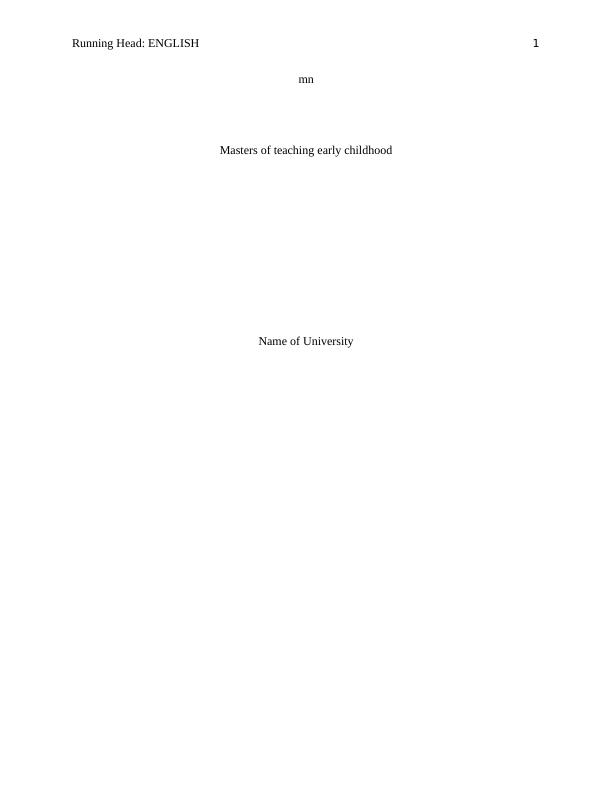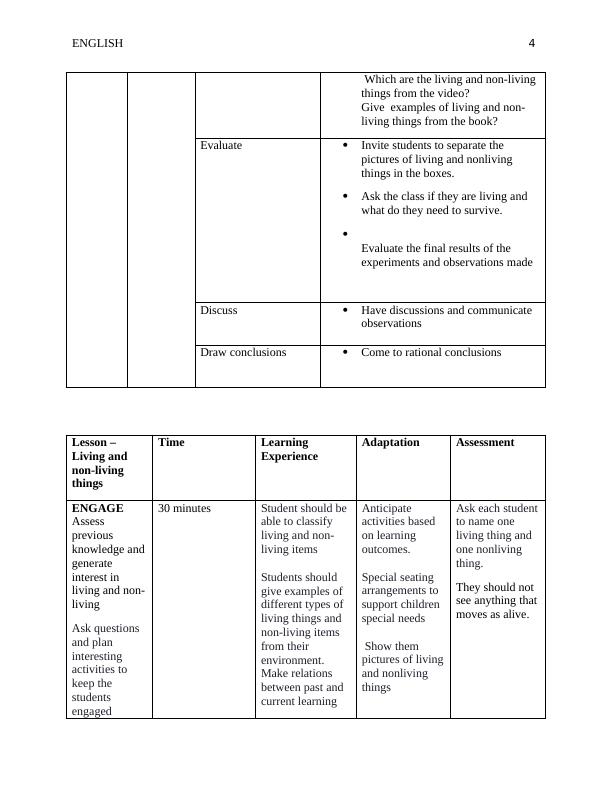Masters of teaching early childhood Assignment 2022
Added on 2022-10-11
11 Pages3168 Words18 Views
Running Head: ENGLISH 1
mn
Masters of teaching early childhood
Name of University
mn
Masters of teaching early childhood
Name of University

ENGLISH 2
Introduction
Young children, principally those who are aged between three to eight years of age are
known to learn best from doing. The children are acutely aware of the world around and use their
senses to experience it. When teaching them science lessons, it would be helpful for the teachers
to take advantage of their curiosity and use experiments to develop their interest in science. A
well-designed lesson plan on since allows the students to get deeply engaged and interested in a
concept before they start their working on it and allows the teachers to make better time plan for
the learn content (Ashbrook, 2017). The paper makes use of 5Es teaching and learning model to
plan a science lesson to discover and understand scientific concepts effectively.
Teaching and learning plan for 5 years old
The biological science topic which is chosen is to distinguish between living and non -
living things that would be carried out across a sequence of 5 lessons. Most science educators are
well aware of the 5E model that is based on five phases - engage, explore, explain, elaborate, and
evaluate.
Topic: Living and non -living things
Key
Concepts
National curriculum
living and
nonliving
things
the
concept of
living
the
concept of
non-living
Science
Understand
ing
(SU)
Biological Sciences Understanding science as an
engaging activity
Focus on life and the significance of
living
Science as
A human
endeavor
(SHE)
Role of science in daily
life and its influences’
Asking questions about life and
different living and non -living
Introduction
Young children, principally those who are aged between three to eight years of age are
known to learn best from doing. The children are acutely aware of the world around and use their
senses to experience it. When teaching them science lessons, it would be helpful for the teachers
to take advantage of their curiosity and use experiments to develop their interest in science. A
well-designed lesson plan on since allows the students to get deeply engaged and interested in a
concept before they start their working on it and allows the teachers to make better time plan for
the learn content (Ashbrook, 2017). The paper makes use of 5Es teaching and learning model to
plan a science lesson to discover and understand scientific concepts effectively.
Teaching and learning plan for 5 years old
The biological science topic which is chosen is to distinguish between living and non -
living things that would be carried out across a sequence of 5 lessons. Most science educators are
well aware of the 5E model that is based on five phases - engage, explore, explain, elaborate, and
evaluate.
Topic: Living and non -living things
Key
Concepts
National curriculum
living and
nonliving
things
the
concept of
living
the
concept of
non-living
Science
Understand
ing
(SU)
Biological Sciences Understanding science as an
engaging activity
Focus on life and the significance of
living
Science as
A human
endeavor
(SHE)
Role of science in daily
life and its influences’
Asking questions about life and
different living and non -living

ENGLISH 3
the
concept of
plants,
animals,
humans
classificat
ion of
living and
nonliving
Science
Inquiry
Skills (SIS)
Questioning and
Guessing
Ask questions about the familiar
objects around in daily life
Explain to students that they will be
learning about living and nonliving
things.
Ask the class questions about living
or nonliving.
Tell them to look around and
observe which are living or
nonliving things.
Allow students to focus on and ask
questions.
Planning and
Conducting
experiments
Carry out certain activities and
experiments and use different tools
to collect information on living and
non-living things
Get books and Videos on Living and
Nonliving Things.
Use pictures of living and nonliving
objects such as small plants, fish,
worms, and common school supplies
and two large boxes
Take them out in the garden to
observe and look for living or
nonliving things.
Read the books and show them a
video on the subject.
Draw pictures of water, food, air,
and shelter on the board.
Study and analyze the
data
Have discussions, make observations
and predictions and compare results
and data
Write questions on the board such as
How to know if something is living
or non-living.
Why is a book is non-living?
Why is a pet or a bird living?
What can living things do?
the
concept of
plants,
animals,
humans
classificat
ion of
living and
nonliving
Science
Inquiry
Skills (SIS)
Questioning and
Guessing
Ask questions about the familiar
objects around in daily life
Explain to students that they will be
learning about living and nonliving
things.
Ask the class questions about living
or nonliving.
Tell them to look around and
observe which are living or
nonliving things.
Allow students to focus on and ask
questions.
Planning and
Conducting
experiments
Carry out certain activities and
experiments and use different tools
to collect information on living and
non-living things
Get books and Videos on Living and
Nonliving Things.
Use pictures of living and nonliving
objects such as small plants, fish,
worms, and common school supplies
and two large boxes
Take them out in the garden to
observe and look for living or
nonliving things.
Read the books and show them a
video on the subject.
Draw pictures of water, food, air,
and shelter on the board.
Study and analyze the
data
Have discussions, make observations
and predictions and compare results
and data
Write questions on the board such as
How to know if something is living
or non-living.
Why is a book is non-living?
Why is a pet or a bird living?
What can living things do?

ENGLISH 4
Which are the living and non-living
things from the video?
Give examples of living and non-
living things from the book?
Evaluate Invite students to separate the
pictures of living and nonliving
things in the boxes.
Ask the class if they are living and
what do they need to survive.
Evaluate the final results of the
experiments and observations made
Discuss Have discussions and communicate
observations
Draw conclusions Come to rational conclusions
Lesson –
Living and
non-living
things
Time Learning
Experience
Adaptation Assessment
ENGAGE
Assess
previous
knowledge and
generate
interest in
living and non-
living
Ask questions
and plan
interesting
activities to
keep the
students
engaged
30 minutes Student should be
able to classify
living and non-
living items
Students should
give examples of
different types of
living things and
non-living items
from their
environment.
Make relations
between past and
current learning
Anticipate
activities based
on learning
outcomes.
Special seating
arrangements to
support children
special needs
Show them
pictures of living
and nonliving
things
Ask each student
to name one
living thing and
one nonliving
thing.
They should not
see anything that
moves as alive.
Which are the living and non-living
things from the video?
Give examples of living and non-
living things from the book?
Evaluate Invite students to separate the
pictures of living and nonliving
things in the boxes.
Ask the class if they are living and
what do they need to survive.
Evaluate the final results of the
experiments and observations made
Discuss Have discussions and communicate
observations
Draw conclusions Come to rational conclusions
Lesson –
Living and
non-living
things
Time Learning
Experience
Adaptation Assessment
ENGAGE
Assess
previous
knowledge and
generate
interest in
living and non-
living
Ask questions
and plan
interesting
activities to
keep the
students
engaged
30 minutes Student should be
able to classify
living and non-
living items
Students should
give examples of
different types of
living things and
non-living items
from their
environment.
Make relations
between past and
current learning
Anticipate
activities based
on learning
outcomes.
Special seating
arrangements to
support children
special needs
Show them
pictures of living
and nonliving
things
Ask each student
to name one
living thing and
one nonliving
thing.
They should not
see anything that
moves as alive.

End of preview
Want to access all the pages? Upload your documents or become a member.
Related Documents
Early Childhood Education: Lesson Plan Evaluationlg...
|21
|4020
|159
5E Model of Instruction: Science Lesson Planlg...
|3
|398
|17
STEM Model for Understanding Ecosystemslg...
|4
|503
|64
Discovering Science Thesis 2022lg...
|6
|1419
|8
Inquiry Modellg...
|4
|544
|71
Early Childhood Mathematics/Science: R-2lg...
|14
|2582
|4
